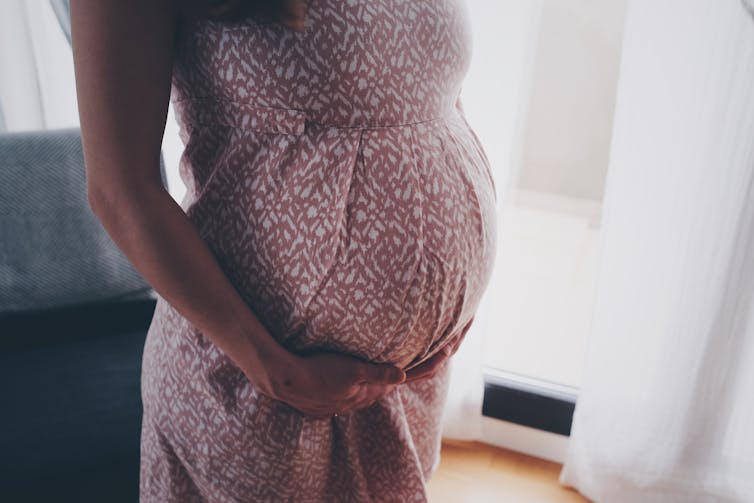
Surrogacy offers the chance of parenthood for those who can't carry a pregnancy for medical or social reasons.
Authors
Ezra Kneebone
PhD Candidate, Monash University
Karin Hammarberg
Senior Research Fellow, Global and Women's Health, School of Public Health & Preventive Medicine, Monash University
Kiri Beilby
Course Coordinator (Graduate Diploma of Reproductive Science), Monash University
In a surrogacy arrangement, a surrogate gives birth to a baby for the intended parents to raise. Most intended parents are heterosexual or gay couples, but single people can also use surrogacy to have a child.
In the 2021-2022 financial year, 213 Australian babies were born through international surrogacy - an arrangement between Australian intended parents and a foreign surrogate. Just 100 surrogacy births were reported by Australian and New Zealand fertility clinics in 2021.
Australian surrogacy laws and ethical guidelines aim to protect the interest of everyone involved with surrogacy. They also recognise the most important consideration of all is the welfare of the children born.
However, children born through international surrogacy aren't protected by Australian laws because they're born overseas. Our new research shows this can increase the physical and psychological risks to the child.
Making surrogacy easier to access in Australia could protect future children born through surrogacy.
How does international surrogacy impact children?
We surveyed more than 300 Australians who were parents through surrogacy, or were planning on having a child via surrogacy. We asked if they had picked international or domestic surrogacy and why, and we asked about the fertility treatment they and their surrogate received.
Respondents who had a child through international surrogacy commonly reported using two fertility treatments currently banned in Australia: multiple embryo transfer and anonymous egg donation.
Surrogates sometimes supply their own egg, but mostly the egg is supplied from one of the intended parents or a donor. Once the egg has been fertilised, the resulting embryo is then transferred to the surrogate.
In Australia, only one embryo can be transferred to surrogates at a time. This is because multiple embryo transfer increases the risk of twin, or even triplet, pregnancies. These pregnancies are linked to higher rates of complications for the pregnant woman and the baby, including preterm birth. Preterm birth is when a baby is born before 37 weeks of pregnancy and is the main cause of death in children below the age of five.

Of the survey respondents who had completed international surrogacy, 37% reported multiple embryos had been transferred to their surrogate. Some 27% of parents through international surrogacy had a preterm baby and 11% had twins or triplets. In contrast, just 11% of parents through surrogacy in Australia had a preterm baby and none had twins or triplets.
If a donor egg is used in Australia, the donor-conceived person can access information about their donor once they turn 18. Anonymous donation is not allowed because research shows many people born through egg or sperm donation want to know the identity of their donor.
Of the respondents who used donor eggs in international surrogacy, 47% said the identity of the donor was anonymous. Australians born through international surrogacy with anonymous egg donors may never know who their genetic mother is.
Why choose international surrogacy?
The most popular reasons for picking international surrogacy were that surrogacy in Australia is long and complicated and it is difficult to find an Australian surrogate.
Most Australian surrogacy arrangements occur between friends and family members. If this is not possible, intended parents can join online communities to meet potential surrogates. However, the number of intended parents in these communities far outweighs the number of surrogates.
For those lucky to find an Australian surrogate, they must complete a series of legal requirements as part of the arrangement. These requirements protect the interests of surrogacy participants and include legal advice, counselling and a court order to transfer parentage from the surrogate to the intended parents.
With international surrogacy, commercial agencies or brokers can match intended parents to a surrogate and the various Australian legal requirements may not be needed.

How can the risks of international surrogacy be reduced?
Intended parents considering international surrogacy should choose single embryo transfers and, if required, a known donor.
However, intended parents may not always be equipped with the information or resources to make this choice. Known donors may not always be available overseas and some of our respondents said they transferred multiple embryos because they were following the advice of their doctor.
Most respondents said they would prefer to complete surrogacy in Australia if it were possible. This means if surrogacy was more accessible in Australia, fewer people might go overseas and more babies might be born in Australia where regulations protect the child's physical and psychological health.
To make surrogacy more accessible, surrogacy laws should be reviewed by an inquiry by the Australian Law Reform Commission. The House of Representatives Standing Committee on Social Policy and Legal Affairs recommended such an inquiry in 2016. This was never undertaken, but we don't know why.
The Law Commission of England and Wales and the Scottish Law Commission recently published recommendations for surrogacy law reform in the United Kingdom. One recommendation removes the need for a court to grant intended parents legal recognition. This is a welcome step forward.
However, the recommendations have also been criticised for not allowing surrogate compensation, which could discourage some people from becoming surrogates. Compensation is financial acknowledgement of the time and effort involved with the surrogacy pregnancy and is currently not allowed in Australia.
Law reform in Australia must address all barriers for domestic surrogacy, including the shortage of surrogates, to protect the welfare of children born through surrogacy.
![]()
Ezra Kneebone receives funding from the Australian Government Department of Education.
Karin Hammarberg works for the Victorian Assisted Reproductive Treatment Authority.
Kiri Beilby does not work for, consult, own shares in or receive funding from any company or organisation that would benefit from this article, and has disclosed no relevant affiliations beyond their academic appointment.






